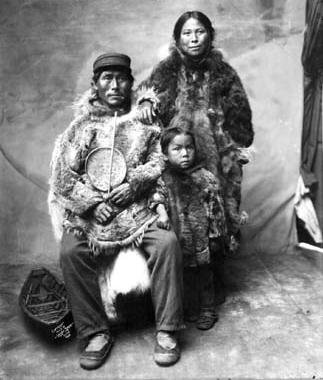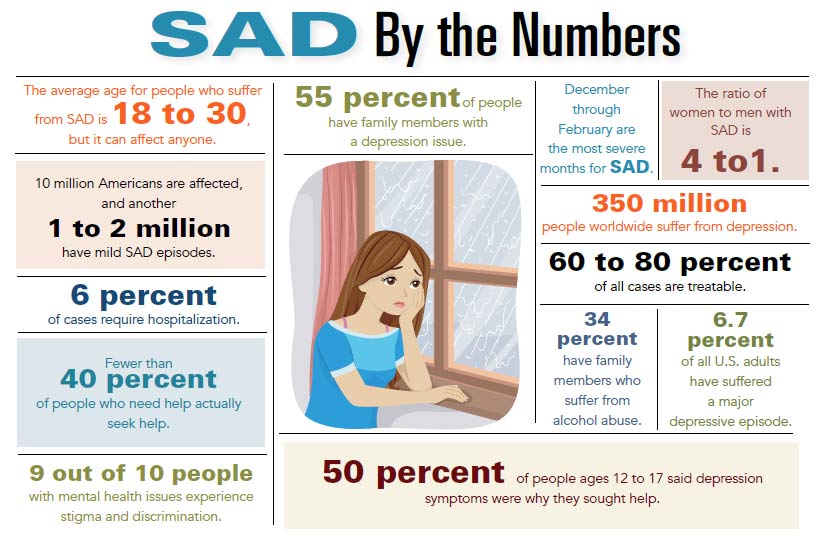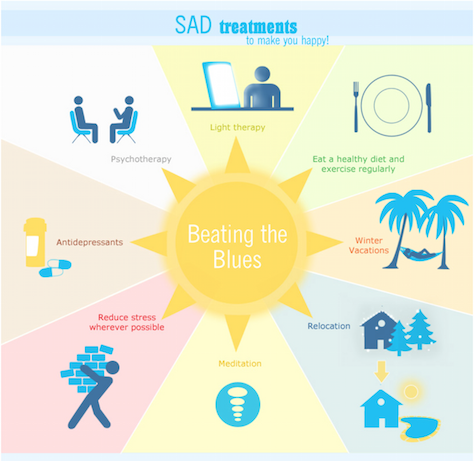Seasonal Affective Disorder Among Arctic Natives
Utqiaġvik, Alaska
Tyler M Baker
Inupiat Eskimos

Inupiat (Eskimos) of Utqiaġvik, AK are part of a large group of Arctic Natives whose cultures span over multiple continents. Living in an area of the world that most wouldn’t even consider, with temperatures below freezing almost year-round, these individuals have learned to adapt to the environment and make the most out of their traditional lifestyles. With an overall population of around 20,700 individuals (1), those not working for one of the numerous oil companies make a living by: reindeer herding, hunting, fishing, and whaling. Though not oblivious to modern ways of doing things, these individuals still like to use the traditional ways of their ancestors in activities of daily living. However, there is a major issue plaguing Arctic Native communities and those of their Native American cousins. Statistically, these individuals have higher rates of mental illness than other cultures within in the United States. Specifically, one factor that studies have shown could be affecting Arctic Natives is Seasonal Affective Disorder.
Seasonal Affective Disorder
Seasonal Affective Disorder (SAD) is a disorder that can affect anyone who experiences mood, energy level, libido, etc. changes based on the weather. The Mayo Clinic characterizes this as “a type of depression that's related to changes in seasons — SAD begins and ends at about the same times every year.” (2). For most people the effects of SAD manifest during the fall and winter months due to gloomier weather with less sunlight. However, for some the effects also take place during the spring and summer months with excess sun light.

Signs and Symptoms for each are below:
Fall and Winter SAD aka "Winter Depression"
Oversleeping
Increased Appetite (Particularly for Carbohydrates)
Weight Gain
Memory Loss
Inability to make decisions
Problems concentrating
Tiredness or Lethargy
Low self-esteem (feeling of worthlessness or guilt)
Suicidal thoughts
Spring and Summer SAD aka "Summer Depression"
Trouble Sleeping (Insomnia)
Poor Appetite
Weight Loss
Agitation or Anxiety (2)
Why is this such a risk for Inupiat Eskimos and other Arctic Natives? Let us take a closer look at the town of Utqiaġvik, AK.
Utqiaġvik, Alaska
The town of Utqiaġvik, commonly called Barrow, Alaska, is the northernmost city that is part of the United States. With a population of around 4,400 people and 60.5% claiming Alaska Native (AN) or American Indian (AI) ancestry, it’s also one of the largest communities of Inupiat Eskimos in the world. Due to the arctic geographical location, with a latitude of 71 degrees, these individuals experience 7-10 weeks of virtually no sunlight (polar night) (3) and roughly 10 weeks of no darkness (midnight sun) each year. It’s also completely overcast for more than 50% of the year. These are prime conditions for the manifestation of SAD and its associated symptoms.
These weather extremes can cause severe changes in individuals sleep cycle, Vitamin D, melatonin, and serotonin levels. For many, this results in observable changes in mood and activities of daily living. If left unchecked, SAD can lead to severe depression, substance abuse, and even suicide. Its effects can create even worse issues for individuals already diagnosed with one of the listed associated symptoms. With the current mental health statistics of Arctic Natives, it poses a huge concern. A study of 111 randomly selected members of an arctic community, similar to those of the Inupiat, showed some pretty startling results. They found, “One in five (22.6%) of the community sample was found to be depressed. Of these, seven (6.3%) had seasonal affective disorder (SAD), with fall onset occurring in six of these (5.4%). Subsyndromal SAD (SSAD) occurred in 11.7%, while any effect of the seasons (seasonality) occurred in 39.6%.” (4). With the average population diagnosed with SAD being between 1-2% (5), it’s easy to see how weather can play a huge part in the mental health of Arctic communities.
Sadly, some individuals suffering the effects result to drugs and alcohol in the hopes it will help them feel better. These coping mechanisms might make them feel better temporarily but usually end up having even more adverse effects. One study found that lifetime prevalence rates of alcohol dependence or abuse within selected AN/AI communities range from 27 to 51 percent (6&7). Also, a 2008 report showed AN/AI suicide rate of 13.1% vs the national average of 3.7% for those over the age of 18 (8). There are many underlying factors that can attributed to these high statistics but it’s hard for one to say SAD can’t be one of them in Arctic Native communities.Thankfully there are healthier home remedies and prescribed medical treatments to combat SAD and its associated symptoms.
SAD Home Remedies and Prescribed Medical Treatments

The best and cheapest remedy for treating SAD is increasing exposure to natural sunlight. However, this isn’t really always an option for Inupiat communities. Especially during the period of “polar night”. In their case, it’s recommend to change their diet to increase Vitamin D intake through eating foods like: sardines, eggs, salmon, tuna, and mushrooms (9). These foods are similar to those of their traditional diet but the effects of colonialism have since caused their everyday diets to change. Studies believe that this dietary change of intaking less Vitamin D could be one of the reasons for an increase in the occurrence of depression. If changing ones diet is out of the question then individuals can always replenish with over the counter Vitamin D supplements.
Another technique to combat the effects is to exercise around 30-60 minutes at least 3x per week. Again, preferably outdoors in the sun but just the exercise itself is beneficial. This will help release endorphins and other chemicals within the body that have shown to be equally as effective as medication in some cases.
If none of the remedies above are effective than there are prescribed medical treatment options available. The more common and westernized being light therapy, medications, and psychotherapy. Details for each are below:
Light therapy can come in many forms but the main being in the form of a battery powered box filled with fluorescent lights. It produces anywhere between 5K-10K lux of light and is usually placed 2-3 feet away, facing the individual. Session times can vary but the average is said to be either ½ hour at 10K lux or one hour at 5K lux(10). This provides similar benefits as natural sunlight, causing the body to create more Vitamin D from the cholesterol in our skin.
Medication treatment is the same for those who experience depression. However, this treatment is usually something that will be taken year-round. To mitigate any negative effects from medication withdrawal, it is safer to keep the individual on the medication and just alter dosage as necessary.
Psychotherapy for SAD is similar to that for PTSD patients. This consists of counseling sessions to identify the negative thoughts or behaviors and find a healthy coping mechanism. The key here is to get the individual out of their comfort zone in order to live a more fulfilling life.
Due to the remote location and climate where the Inupiat Eskimos live, it’s not always easy to get to the westernized treatments. Anyone who lives just outside the city needs to be airlifted to the Samuel Simmonds Memorial Hospital for care since there are no roads leading in or out of Barrow. Due to similar difficulties, roughly 34-49% of Alaska Natives will seek their traditional healers to “focus on balancing mind, body and spirit within the community context” (11) before trying a westernized approach. All of which have been shown to be successful.
Conclusion
SAD and its associated symptoms are clearly affecting Arctic Natives today. Especially with the harsh climate and long periods of darkness and light that the Inupiat Eskimos endure through the year. The key to helping combat the high mental illness statistics is to get help when symptoms are recognized. There are SAD treatments options available. Since both westernized and traditional treatment methods have been found to be beneficial, it’s up to the person to make the call based on availability to them and their personal preference. By recognizing and seeking help, they can start to reduce AN/AI mental illness statistics and start promoting better mental health within their communities.
References
(1) "Inupiaq (Inupiat)—Alaska Native Cultural Profile." National Network of Libraries of Medicine. Retrieved 4 Dec 2013.
(2) "Seasonal Affective Disorder (SAD)." Mayo Clinic. October 25, 2017.
(3) "Barrow, Alaska." Wikipedia. April 05, 2018. Accessed April 05, 2018.
(4) Haggarty, J. M., Z. Cernovsky, M. Husni, K. Minor, P. Kermeen, and H. Merskey. "Seasonal Affective Disorder in an Arctic Community." Acta Psychiatrica Scandinavica. May 2002. Accessed April 05, 2018.
(5) "Seasonal Affective Disorder (SAD)." Recognizing and Treating the Winter Blues. Accessed April 16, 2018.
(6) Shore. "A Pilot Study of Depression Among American Indian Patients with Research Diagnostic Criteria." American Indian and Alaska Native Mental Health Research 1, no. 2 (1987): 4-15. doi:10.5820/aian.0102.1987.4.
(7) Beals, Janette. "Prevalence of DSM-IV Disorders and Attendant Help-Seeking in 2 American Indian Reservation Populations." Archives of General Psychiatry 62, no. 1 (2005): 99. doi:10.1001/archpsyc.62.1.99.
(8) Kinzie, J. David, Paul K. Leung, James Boehnlein, Don Matsunaga, Robert Johnson, Spero Manson, James H. Shore, John Heinz, and Mary Williams. "Psychiatric Epidemiology of an Indian Village." The Journal of Nervous and Mental Disease 180, no. 1 (1992): 33-39. doi:10.1097/00005053-199201000-00008.
(9) Axe, Josh. "Top 10 Vitamin D Rich Foods." Dr. Axe. September 02, 2017. Accessed April 16, 2018.
(10) "Seasonal Affective Disorder (SAD) Information." Light Therapy Products. Accessed April 09, 2018.
(11) Mental Health Disparities: American Indians and Alaska Natives. Report. 2010. Accessed April 9, 2018.
Image Sources:
Image 1: Inuit Family in Winter Clothing. 1903. Lomen Brothers, Nome, AK. glenbowmuseum via Flickr. April 28, 2011. Accessed April 9, 2018.
Image 2: James, Denise K. Seasonal Affective Disorder (SAD) by the Numbers. In Beating Seasonal Affective Disorder Depression. 2018. Accessed April 9, 2018.
Image 3: Sad Treatments to Make You Happy "Beating the Blues". In How To Feel Like It's June In January And Stay Happy Year Round. November 23, 2014. Accessed April 9, 2018.